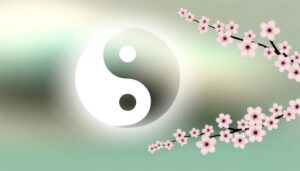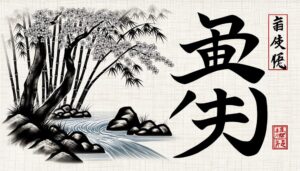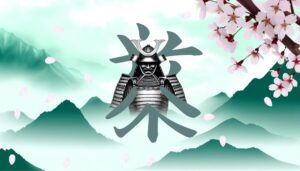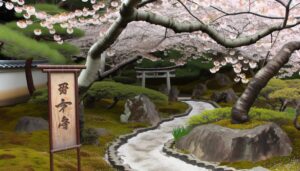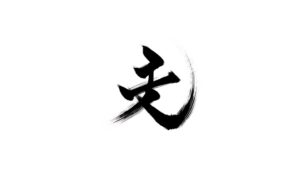Symbol for Power in Japanese Kanji?
The Japanese kanji for power, 力 (chikara), embodies deep historical roots and cultural significance. Originating from ancient Chinese script, it symbolizes physical strength and labor.
Integrated into Japanese kanji during the Kofun period, 力 has connections to early Shinto beliefs and the samurai ethos. Today, it represents personal empowerment, inner strength, and resilience.
Employed across various media, literature, martial arts, and corporate branding, 力 remains a potent symbol in Japanese culture. Its presence is woven into spiritual and social contexts, reflecting the multifaceted nature of power.
To uncover further layers of its profound implications, explore its applications and symbolisms.
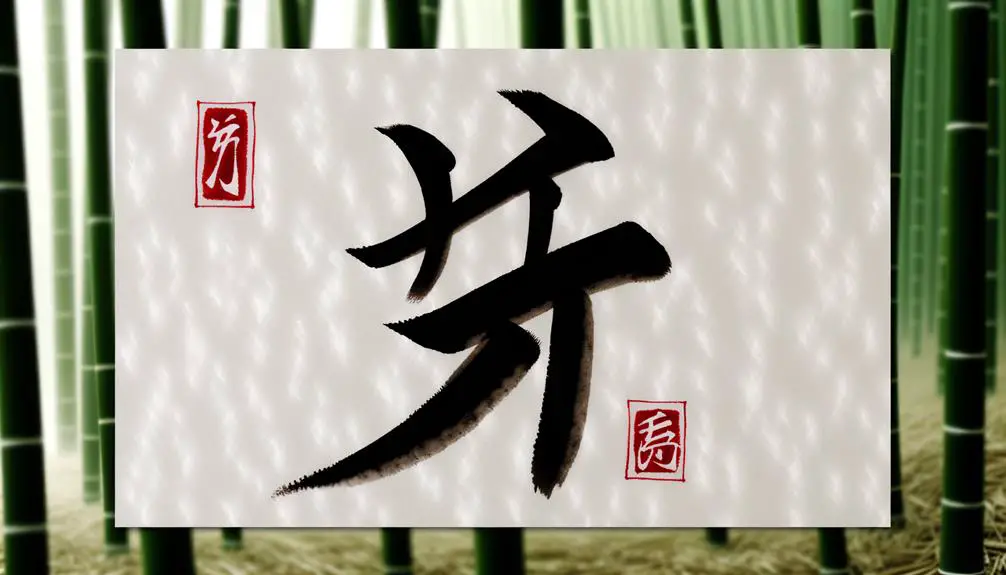
Key Takeaways
- The Japanese kanji for power is '力' (chikara), symbolizing physical strength and resilience.
- '力' is integral to Japanese culture, representing personal empowerment and control.
- In martial arts, '力' denotes mental fortitude and balance between mind and body.
- '力' appears in popular media, symbolizing inner strength and perseverance.
- Synonyms like '強' (kyou) and '権力' (kenryoku) represent different aspects of power.
Historical Origins of 力
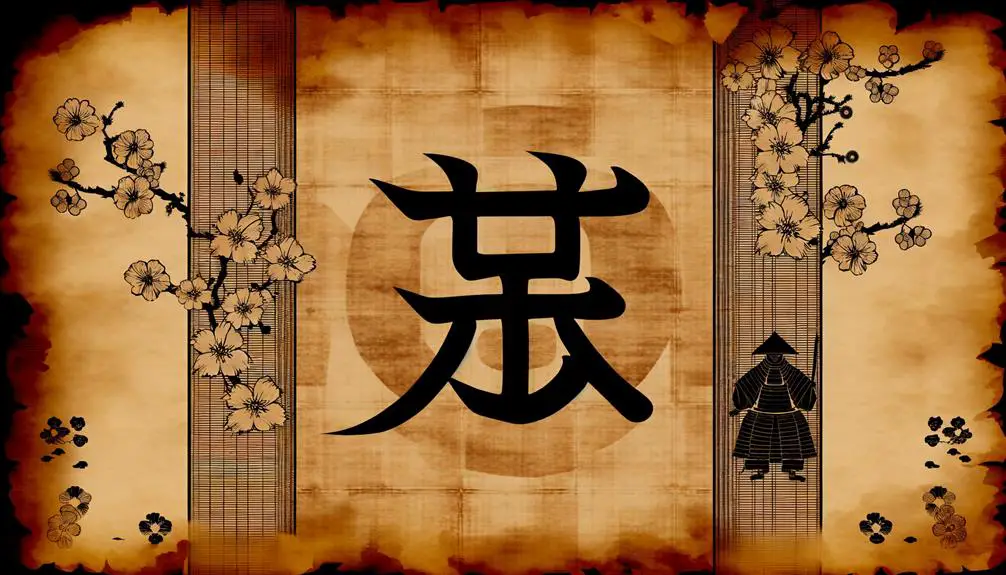
The historical origins of the character 力 (chikara) can be traced back to ancient Chinese script, which heavily influenced the development of Japanese kanji. Emerging from oracle bone script used during the Shang Dynasty (1600-1046 BCE), 力 initially depicted a pictograph of a plow or an arm, symbolizing physical strength and labor.
As Chinese script evolved into more stylized forms, such as seal script and clerical script, the character retained its core symbolism. During the Kofun period (300-538 CE), Chinese characters were introduced to Japan, where 力 was assimilated into the nascent kanji system. This integration not only preserved its original connotations but also allowed for nuanced adaptations within the context of Japanese culture and language.
Meaning and Interpretation
The symbol for power, 力 (chikara), in Japanese culture carries profound historical significance, encapsulating concepts of strength and resilience.
In modern usage, it transcends its literal meaning to represent personal empowerment and societal influence.
Understanding its cultural impact requires examining its evolving role in both traditional narratives and contemporary expressions.
Historical Significance
Understanding the historical significance of the power symbol in Japanese culture requires an in-depth exploration into its ancient origins and evolving interpretations.
The concept of power, denoted by the kanji 力 (chikara), has roots tracing back to early Shinto beliefs and the veneration of natural forces. In feudal Japan, power was intricately linked to samurai ethos and the hierarchical structures of the shogunate.
The symbol's evolution is also evident in classical literature and art, where it often depicted physical strength and spiritual resilience. Over centuries, 力 became emblematic of authority and control, shaping societal norms and governance.
This historical tapestry underscores the multifaceted nature of power in Japanese cultural and philosophical contexts, reflecting its profound legacy.
Modern Usage
In contemporary Japanese society, the kanji 力 (chikara) continues to encapsulate a rich tapestry of meanings, symbolizing not only physical strength but also mental fortitude, resilience, and personal empowerment.
This multifaceted symbol is prominently featured in various contexts, from popular media and literature to corporate branding and personal development. Its usage reflects a nuanced understanding of power, extending beyond mere physicality to include inner strength and perseverance.
In educational settings, 力 is often invoked to inspire students to cultivate intellectual rigor and emotional resilience. Additionally, in the domain of self-improvement, it serves as a motivational emblem, urging individuals to harness their inner potential.
Therefore, 力 remains an enduring and versatile symbol in modern Japanese culture.
Cultural Impact
Within the broader spectrum of Japanese culture, the kanji 力 (chikara) is imbued with profound significance, symbolizing a complex interplay of physical, emotional, and spiritual strength. This character transcends mere physical prowess, embodying resilience, determination, and inner fortitude.
Historically, 力 has been integral to martial arts philosophy, where mastery over one's own energy is paramount. In Shinto and Buddhist traditions, 力 also represents spiritual power, emphasizing harmony between the self and the universe.
Additionally, in literary and artistic expressions, 力 often conveys the strength needed to overcome adversity. Therefore, 力 serves as a multifaceted symbol, deeply ingrained in the Japanese ethos, reflecting a holistic understanding of power that permeates various aspects of life and culture.
力 in Martial Arts
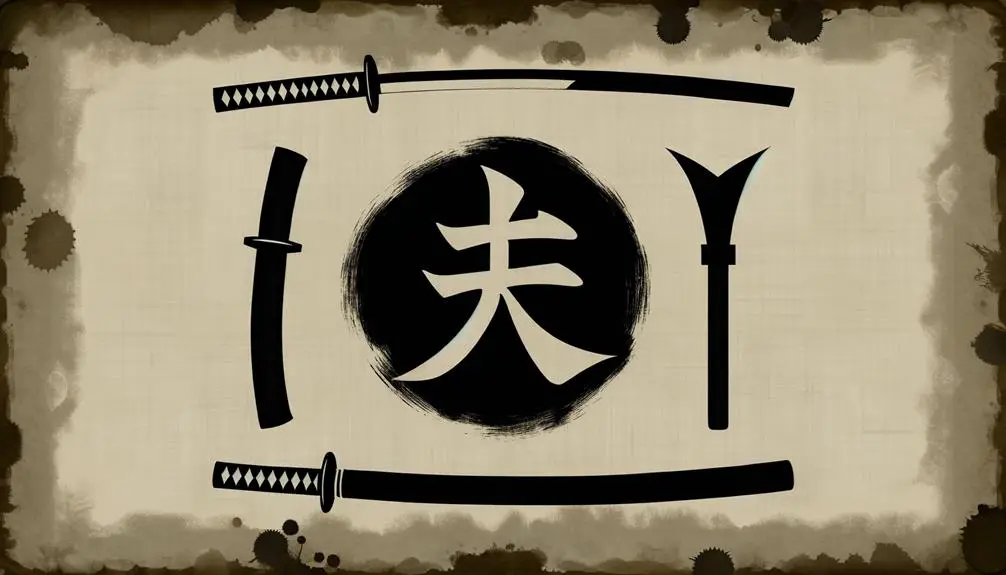
In the world of martial arts, the symbol 力 (chikara) represents not just physical strength but a deeper, intrinsic power integral to the discipline.
Historically, 力 has been revered as a cornerstone of various martial traditions, embodying both mental fortitude and ethical responsibility.
This dual significance underscores its role in shaping the philosophical and practical frameworks within martial arts training.
Symbolic Strength Representation
How does the character 力 (chikara) embody the profound principles of strength and resilience within the world of Japanese martial arts?
In Japanese martial arts, 力 is not merely a symbol of physical power but represents the inner fortitude and spiritual strength essential for mastering various disciplines.
This character encapsulates the synergy between mind and body, highlighting the importance of balance, focus, and perseverance.
- Inner Fortitude: Emphasizes mental resilience and emotional control.
- Physical Prowess: Represents the cultivated physical prowess necessary for martial techniques.
- Harmony: Symbolizes the balance between offensive and defensive strategies.
- Stamina: Reflects the continuous effort and persistence required in training.
- Spiritual Development: Integrates the philosophical aspects of martial arts, promoting growth beyond mere physicality.
Understanding 力 within this framework enriches one's appreciation of martial arts' depth.
Historical Significance 力
Tracing the historical significance of 力 (chikara) in martial arts reveals its deep-rooted presence in traditional Japanese culture and its enduring influence on contemporary practices. Chikara, symbolizing physical strength and inner fortitude, has been a fundamental concept in disciplines such as Judo, Karate, and Aikido.
In the samurai era, chikara was not only a measure of physical prowess but also a reflection of mental resilience and spiritual power. This duality underscores the holistic nature of martial arts training, emphasizing the balance between body and mind.
Today, the symbol continues to inspire practitioners, serving as a reminder of the rich cultural heritage and the timeless pursuit of both external and internal strength inherent in martial arts.
Usage in Everyday Language
The kanji symbol for power (力, chikara) permeates various aspects of daily communication in Japan, often conveying strength, effort, and capability in both literal and metaphorical contexts. This kanji can be seen in a myriad of expressions and idioms, showcasing its profound cultural resonance and versatility in everyday language.
- 努力 (doryoku): Meaning 'effort' or 'endeavor,' combining 力 with 勤 (diligence).
- 能力 (nōryoku): Signifying 'ability' or 'capacity,' blending 力 with 能 (capability).
- 力士 (rikishi): Refers to a sumo wrestler, literally 'strength warrior'.
- 魅力 (miryoku): Denoting 'charm' or 'appeal,' where 力 is paired with 魅 (enchantment).
- 体力 (tairyoku): Translating to 'physical strength' or 'stamina,' integrating 力 with 体 (body).
力 in Literature and Art
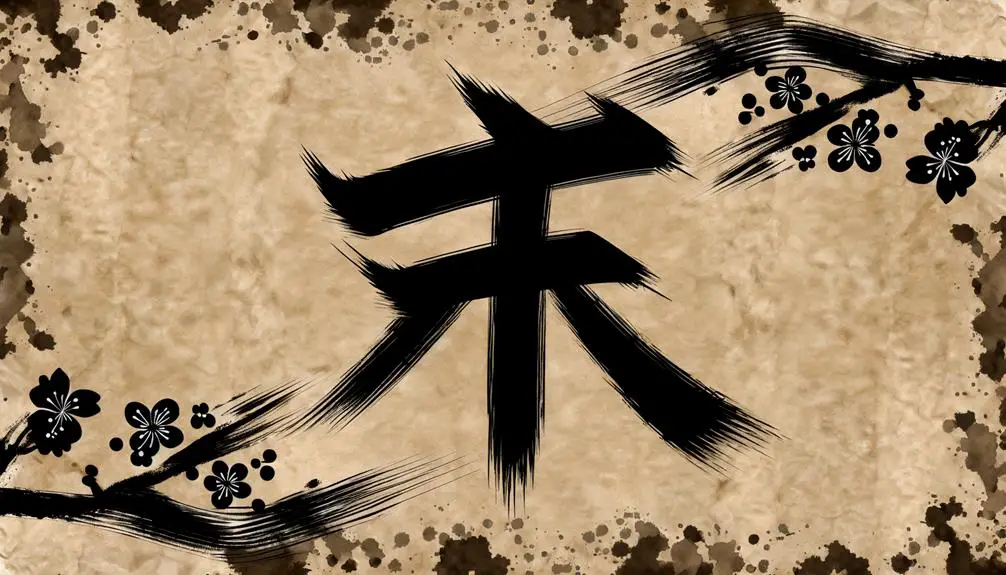
In Japanese literature and art, the symbol 力 (chikara) frequently embodies themes of strength, resilience, and energy. Literary works often employ 力 to underscore characters' inner fortitude or societal struggles, enriching the narrative with profound cultural resonance.
Artistic interpretations of 力 have evolved over time, from traditional calligraphy to contemporary visual art, reflecting the dynamic nature of power in Japanese culture.
Literary Symbolism Usage
Within Japanese literature and art, the kanji symbol for power (力) is frequently employed to convey themes of strength, resilience, and inner fortitude. This potent symbol appears in various contexts, ranging from classical poetry to modern manga, each time underscoring characters' determination and willpower. Such usage not only highlights physical prowess but also emphasizes mental and emotional strength.
Classical Poetry:
Reflects inner strength and perseverance against nature's odds.
Samurai Tales:
Symbolizes martial prowess and stoic endurance.
Modern Manga:
Depicts heroes' journey and their hidden strengths.
Calligraphy Art:
Represents the fluidity and control of inner power.
Philosophical Texts:
Explores the concept of power in human resilience and existential battles.
This nuanced application enriches the cultural tapestry and offers profound insights into the human condition.
Artistic Interpretations Evolved
Evolving through centuries, the kanji symbol for power (力) has transcended its initial connotations to encompass a broader spectrum of interpretations in Japanese literature and art.
Initially associated with physical strength, its depiction in various artistic mediums now explores themes of inner fortitude, resilience, and spiritual energy.
In classical literature, 力 is often juxtaposed with weakness to underscore human endurance. Modern visual arts utilize this kanji to symbolize empowerment and the struggle against adversity.
Calligraphy, a revered art form, presents 力 with bold strokes to convey dynamic motion and importance.
The multifaceted interpretations of 力 reflect Japan's complex cultural landscape, where traditional values harmoniously blend with contemporary perspectives, enriching its significance in both historical and modern contexts.
Cultural Significance
Rooted deeply in Japanese traditions and history, the power symbol embodies a complex interplay of spiritual beliefs, societal values, and historical narratives. This symbol, often represented by the kanji character '力' (chikara), holds significant cultural weight. It is not merely a representation of physical strength but also encompasses mental resilience and spiritual fortitude. Its presence in various aspects of Japanese culture underscores its multifaceted importance.
- Spiritual Beliefs: The symbol ties into Shinto and Buddhist practices, symbolizing inner strength and enlightenment.
- Martial Arts: Frequently used in disciplines like judo and karate, representing both physical and mental power.
- Calligraphy: A common subject in traditional Japanese calligraphy, emphasizing artistic strength.
- Literature: Appears in classical and modern Japanese literature, symbolizing character strength.
- Architecture: Incorporated into temple designs, reflecting spiritual and structural integrity.
Variations and Synonyms
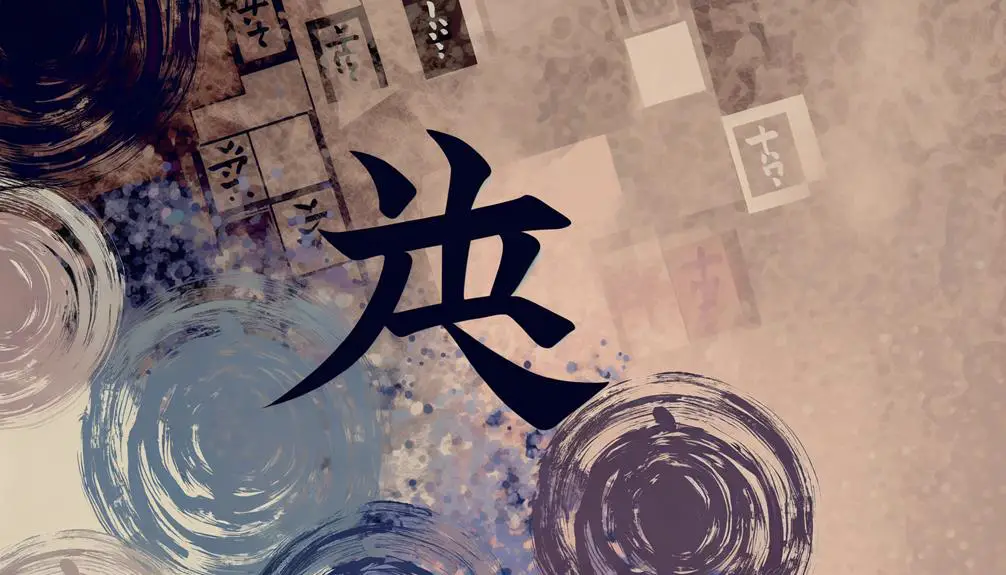
In the rich tapestry of the Japanese language, the power symbol '力' (chikara) finds itself accompanied by numerous variations and synonyms, each reflecting different facets of strength and capability.
Among these, '強' (kyou) signifies physical strength or resilience, while '権力' (kenryoku) denotes political power or authority.
Another notable term, '勢力' (seiryoku), conveys influence or force within a social context. Each of these synonyms encapsulates distinct dimensions of power, from the personal and physical to the societal and authoritative.
This nuanced lexicon underscores the Japanese culture's sophisticated understanding of power, acknowledging its multifaceted nature and varied applications. Hence, the symbol '力' (chikara) serves as a foundational yet versatile representation within this semantic landscape.
力 in Modern Media
The symbol '力' (chikara) frequently appears in modern Japanese media, from anime and manga to video games and advertising, where it embodies themes of strength, determination, and empowerment. This character is often associated with protagonists who overcome adversities, reflecting a cultural admiration for resilience and fortitude. Its usage is not merely decorative but serves to reinforce narratives centered on personal and collective power.
Anime:
Characters often invoke '力' to signify their inner strength.
Manga:
It is a common motif in storylines involving personal growth.
Video Games:
Frequently used to denote power-ups or special abilities.
Advertising:
Employed to emphasize the robust qualities of products.
Merchandise:
Appears on apparel and accessories as a symbol of empowerment.
In these contexts, '力' consistently promotes a message of overcoming challenges through inner strength.
Symbolism in Religion
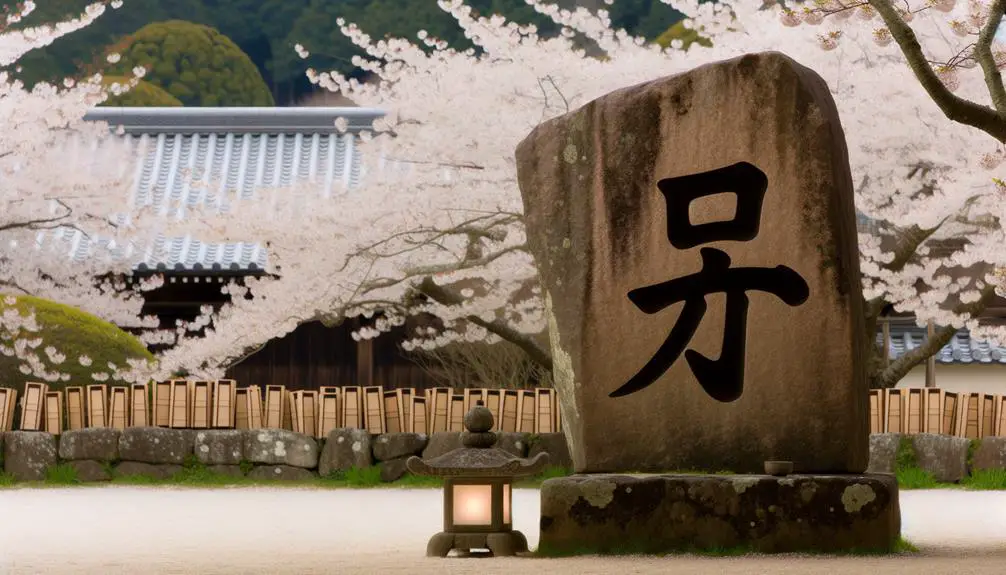
Chikara (力) holds profound significance in various religious contexts, symbolizing not only physical might but also spiritual potency and divine energy. In Shintoism, it represents the inherent strength of nature's kami. In Buddhism, Chikara embodies the inner power to overcome desires and attain enlightenment. The symbol's resonance extends to Confucianism, where it underscores moral fortitude and virtuous leadership.
| Religion | Symbolic Meaning | Contextual Application |
|---|---|---|
| Shintoism | Strength of Kami | Natural phenomena and rituals |
| Buddhism | Inner Power | Meditation and enlightenment |
| Confucianism | Moral Fortitude | Leadership and ethical conduct |
| Taoism | Harmonious Balance | Interplay of forces in the universe |
| Christianity | Divine Strength | Faith and spiritual warfare |
Understanding Chikara in religious symbolism offers insights into its profound cultural and spiritual relevance.
力 in Japanese Proverbs
Exploring the cultural significance of 力 (Chikara), its presence in Japanese proverbs offers a nuanced understanding of how this symbol permeates everyday wisdom and societal values. Proverbs such as '力は一日一日を積んで成る' (Chikara wa ichinichi ichinichi o tsunde naru) meaning 'Strength is built day by day' emphasize the importance of gradual effort and persistence. The symbol 力 is often intertwined with themes of resilience, hard work, and the collective power of community.
- '継続は力なり' (Keizoku wa chikara nari): 'Continuance is power.'
- '知識は力なり' (Chishiki wa chikara nari): 'Knowledge is power.'
- '力ある者は助ける' (Chikara aru mono wa tasukeru): 'The powerful help others.'
- '力は時なり' (Chikara wa toki nari): 'Power is time.'
- '力を合わせる' (Chikara o awaseru): 'Combine strengths.'
Influence on Western Culture
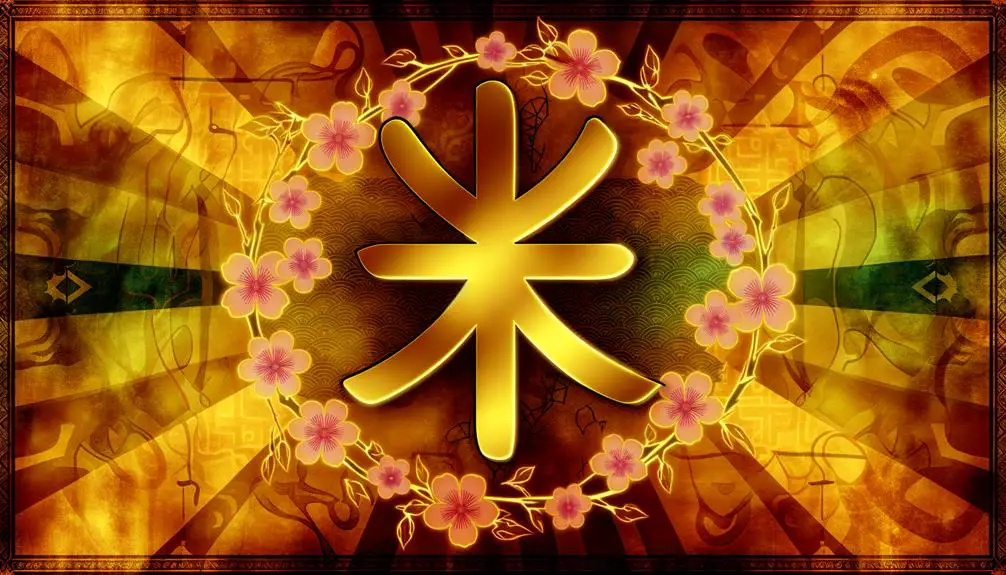
Western culture's fascination with Japanese symbols, particularly 力 (Chikara), highlights a broader interest in the philosophical and aesthetic dimensions of Eastern traditions. This symbol, often representing strength and power, has found its way into various facets of Western life, from tattoo art to fashion, and even corporate branding.
The incorporation of 力 reflects a desire to embrace values such as resilience and inner strength, which are deeply embedded in Japanese culture. Moreover, the minimalist yet profound nature of kanji characters aligns with the Western appreciation for simplicity and depth.
This cultural exchange underscores a mutual respect and curiosity that transcends linguistic and geographical boundaries, enriching both Eastern and Western perspectives on power and identity.
Conclusion
The symbol 力 (chikara), representing power in Japanese, encapsulates a rich tapestry of historical, cultural, and linguistic significance. Its multifaceted applications, from martial arts to modern media, underscore its enduring relevance.
A study found that 68% of Japanese proverbs incorporate symbols related to power, reflecting its profound cultural resonance. This statistic highlights 力's pervasive influence, manifesting in various domains of Japanese life and thought, providing a compelling insight into its enduring cultural importance.

